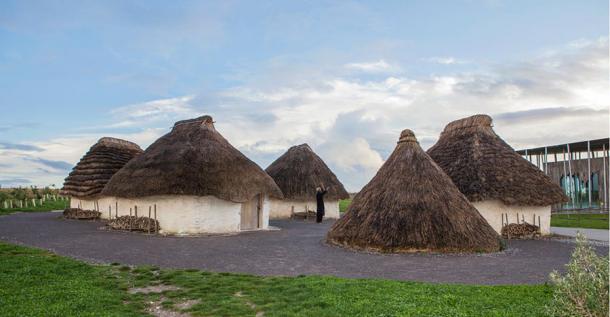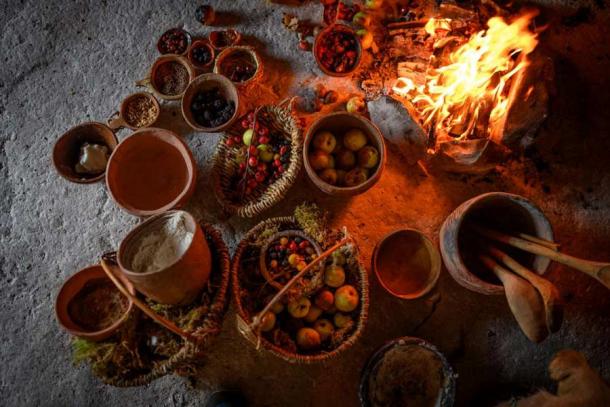Just 2 miles (3.2 km) northeast of Stonehenge in England, Durrington Walls is a huge Neolithic settlement and henge site. Located within the Stonehenge World Heritage Site, excavations back in 2004 and 2006 by the University of Sheffield Riverside Project revealed evidence of seven ancient houses. The finding of as many as 1,000 houses and 4,000 inhabitants determined this was an important center of early Neolithic occupation, inhabited by the builders of Stonehenge about 2,500 BC. Now, the Stonehenge Riverside Project has revealed that Stonehenge’s builders fueled themselves on high carb and calorie snacks dubbed “Neolithic mince pies”.

Reconstruction of one of the Neolithic houses unearthed at Durrington Walls near Stonehenge, once inhabited by Stonehenge builders. ( English Heritage )
Unearthing Evidence of Stonehenge Builders in Mysterious Circular Pits
Earlier this month archaeologists excavated a series of 20 deep pits at Durrington Walls just north of Amesbury in Wiltshire. They were intent on demonstrating that a series of depressions discovered last year were human made, as many experts suggested they were merely natural features. Measuring more than 30 feet (9.1 m) across and 16 feet (4.8 m) deep, the 20 pits formed a circle around the Durrington Walls settlement, suggesting their placement was anything but natural.
It was in samples taken from these pits that the ancient ingredients were found, that together constitute the so-called “Neolithic mince pies”. The BBC reported that the discovery of “hazelnuts, sloes, crab apples and other fruits” informed the researchers that people had foraged for the ingredients. While direct evidence of pastry being used in the Neolithic amounts to nothing, cereal crops were grown. This fact led the researchers to speculate that these Stonehenge builders could have made a wheat pastry and used the hazelnut, or acorn, flour to form crude mince pies.

Within the pits at Durrington Walls archaeologists found evidence of the ingredients they believe were used to make Neolithic mince pies. ( English Heritage )
Ancient Welsh Cakes and Other High Sugar Bakes
It is known that Durrington Walls was occupied for only part of the calendar year, and previous excavations found evidence of community wide ritual feasts. Susan Greaney, English Heritage’s senior properties historian, told the BBC that these “festive Neolithic treats” may have been baked on a hot flat stone, in a ceramic pot or heated in the embers of a fire – “rather like a Welsh cake.”
Greaney said because it was so hard to gather ingredients, this might indicate that such foods were only eaten at times of celebration, like around harvest time. This way, the sharing of superfoods would have served to bond the agricultural community. Greaney goes so far as to think that maybe these rich cakes might have encouraged people to “travel from far and wide to help build Stonehenge.” On the other hand, in the practical world of farming, by mixing fatty calorie loaded meats with hazelnuts and fruits, the people would have made a really effective fast release energy bars.
So nice we cooked them twice!
This festive season, try one of our recipes for mince pies using ingredients inspired by Neolithic food remains found near Stonehenge. Follow the modern version for oven cooking or for a challenge, try the Neolithic method. https://t.co/SQE6W1lcpI pic.twitter.com/r1EVY6eLbb— Stonehenge (@EH_Stonehenge) December 2, 2021
Recreating the Neolithic Bakes of Stonehenge Builders
Even when researchers identify samples of ancient foods, it is almost impossible to tell exactly how they were prepared and consumed. In this instance the researchers concluded that while it will never be known for certain what recipes the people favored, “it’s fun to imagine travelers being greeted with a tray of mince pies,” just like we do today around the holidays.
It has long been known that the Stonehenge’s builders ate pork, beef and dairy products, and now we know they savored sweet foods as well. Furthermore, charred plant remains discovered at Durrington Walls during the recent digs suggest set production methods were developed and maintained “to preserve and make foods palatable.” Susan Greaney said it is known that “midwinter and feasting were really important to the builders of Stonehenge.” For that reason, English Heritage volunteers will bake festive Neolithic mince pies every Monday this December.
Top image: Archaeologists believe that Stonehenge builders ate Neolithic mince pies. Source: English Heritage
By Ashley Cowie
Related posts:
Views: 0
 RSS Feed
RSS Feed

















 December 3rd, 2021
December 3rd, 2021  Awake Goy
Awake Goy  Posted in
Posted in  Tags:
Tags: 
















